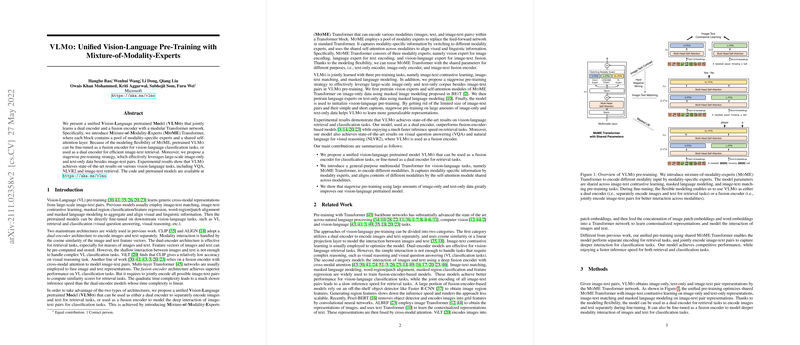Overview of VLMo: Unified Vision-Language Pre-Training with Mixture-of-Modality-Experts
The paper in discussion presents VLMo, a Vision-Language Pretrained Model designed to enhance the integration and application of vision and language understanding tasks. VLMo employs a novel approach called the Mixture-of-Modality-Experts (MoME) Transformer, unifying the functionalities of a dual encoder and a fusion encoder within a modular Transformer architecture. This strategic integration aims to improve both vision-language classification and image-text retrieval tasks.
Core Contributions
- Mixture-of-Modality-Experts Transformations: The core innovation of VLMo is the MoME Transformer, which utilizes modality-specific experts coupled with a shared self-attention layer. This design allows the model to process images and text both separately and together, maintaining modality-specific encoding while also aligning them through shared parameters. The modality experts (vision, language, and vision-language) are responsible for handling different modalities in a flexible yet cohesive manner.
- Stagewise Pre-Training Strategy: VLMo incorporates a stagewise pre-training approach, utilizing large datasets of image-only and text-only data in addition to image-text pairs. This methodology capitalizes on the vastness and variety inherent in uni-modal data to bolster the generalization abilities of the model across both modalities, a notable deviation from relying solely on paired datasets.
- Unified Pre-Training Tasks: The paper proposes simultaneous training on image-text contrastive learning, masked LLMing, and image-text matching. This joint training framework ensures that VLMo captures the nuanced relationship between visual and linguistic content.
Experimental Outcomes
VLMo demonstrates superior performance across well-recognized vision-language tasks such as Visual Question Answering (VQA) and Natural Language Visual Reasoning (NLVR2). For example, the large-size VLMo model outperforms current models, achieving a VQA test-dev score of 82.88 and an NLVR2 test accuracy of 88.62. These results underscore the efficacy of combining the dual encoder and fusion encoder approaches, managed through a unified system.
In addition to the classification benchmarks, VLMo shows substantial gains in image and text retrieval tasks. The separation of encoding—enabled by the dual encoder capability—results in a more efficient retrieval process, optimizing both accuracy and speed.
Implications and Future Directions
The VLMo framework has practical implications for a range of AI applications requiring simultaneous processing of textual and visual information, such as multimedia search engines, content moderation tools, and interactive AI systems. Furthermore, the theoretical strides made in modality integration can pave the way for more intricate assemblages in pre-training models.
In terms of future developments, scaling up the VLMo model size and exploring its application in generation tasks like image captioning appears promising. Another avenue involves extending VLMo to accommodate more modalities beyond vision and language, possibly incorporating video or audio for a truly multimodal AI platform.
In conclusion, VLMo represents a significant advancement in vision-language pre-training models. Its amalgamation of modality-specific learning with shared cross-modal attention offers an efficient, versatile approach to addressing the diverse challenges of vision-language tasks.
